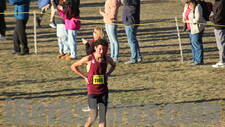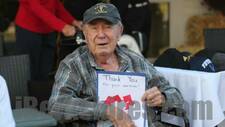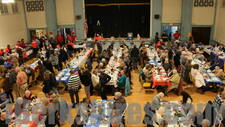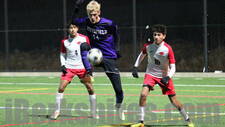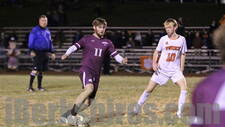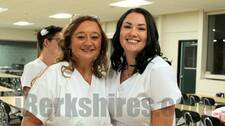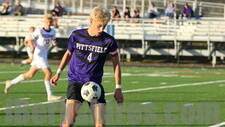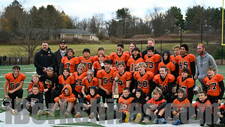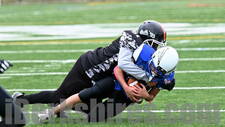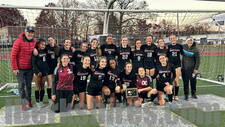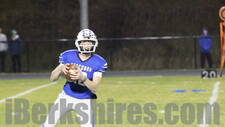iBerkshires.com Columnist SectionSue Bush
More articles from Sue Bush
Clarksburg Students To Erect Holocaust MuseumBy Susan Bush
12:00AM / Wednesday, June 07, 2006
 | | Clarksburg Elementary School eighth grade students will host a Holocaust exhibit on June 15. |
Clarksburg - Clarksburg Elementary School teacher Michael Little delivered heartfelt praise to his eighth grade students.
"My students have worked incredibly hard," Little said during a June 6 interview. "They have dug deep and worked harder than I ever expected."
Holocaust Exhibit
The students have focused on the Holocaust over the past five weeks; their work involves creating a temporary museum featuring about 250 Holocaust artifacts that will be open to the public for a one-night only June 15 event.
The event is scheduled to begin at 6 p.m. at the school. Exhibits will be set up at the school gymnasium and speakers, including Lodz Ghetto survivor George Torrey and the Hativah Holocaust Education Center Director Rabbi Robert Sternberg, will be situated in classrooms.
A copy of Schindler's List, a list of Jewish workers assembled by German factory owner Oskar Schindler that ultimately saved their lives, is expected to be included in the display, Little said.
Schindler lost his acquired wealth through bribes and other means that kept the workers alive and working at his "Emalia" factory. His story was the foundation of Steven Spielberg's acclaimed movie "Schindler's List."
Students are gathering 194 pairs of shoes that will be part of the exhibit.
"The shoes will symbolize the number of Clarksburg Elementary School students that would have been saved if they were on Schindler's List," Little said.
A Story of Survival Against All Odds
Torrey will meet with the students prior to the public event and speak with them about his experiences at Lodz, Little said.
Torrey was a child when Adolf Hitler ordered a Nazi attack on Poland in 1939.
The Polish city of Lodz was home to thousands of Jewish people. On Nov. 7, 1939, Lodz was renamed Litzmannstadt and became a part of the Third Reich. It was there that Jewish citizens were forced to display armbands that identified them as Jews; the armbands were the predecessors to the forced wearing of a yellow Star of David insignia
In February 1940, Jews were ordered to leave their homes and relocate to a "ghetto" being established within the city that had been Lodz. In April of that year, the ghetto was fenced off and by May 1, the Lodz ghetto was closed and separated from the rest of the city and the country with about 230,000 Jews crammed within its' fences.
The ghetto became a work-camp and the residents were forced to labor and were paid with food. Minimal food was delivered in bulk, but what wasn't already spoiled was often taken by camp officers. A rationing program was put into place. More people were brought to the ghetto, and then, as time passed, people began being taken from the ghetto to be killed by carbon monoxide gas at the Chelmno death camp.
Those who were trapped at the Lodz ghetto faced unimaginable hardships, including starvation and sickness, for the just over four years of its' existence. When the ghetto was liberated on January 19, 1945, almost all of its' residents had been killed or moved to the Auschwitz camp. When the ghetto was liberated, 877 of the about 280,000 people brought there remained.
The Holocaust exhibit was crafted to be "respectful" and "probing," Little said.
"It's an inquiry into the darkness," he said.
"No One Should Sit Silent For Genocide"
Darrell English is permitting use of a collection of artifacts for the event. English has agreed to attend the event and speak about the objects, Little said.
"These artifacts are meaningful and there is a story to each one," he said. "The students have worked very hard to bring the story out."
Military veterans from any time period are invited to participate and share their memories with those who attend the exhibit, Little said.
"I have spoken to veterans who believe that the stories are being forgotten," he said.
The Holocaust represents what may well be the bleakest time in 20th century world history and should be taught and remembered, Little said.
"To me, if you look at that story, there's almost no story after that," he said. "The words [to describe the Holocausts' horrors] become inadequate."
But silence may be a greater enemy, Little said, and that may be one of the most powerful lessons of the Holocaust.
"No one should sit silent for any genocide."
Susan Bush may be reached via e-mail at suebush@iberkshires.com or at 802-823-9367. |
Congratulations to the Clarksburg students, and teacher(s), for undertaking this project. Education is the huge first step towards prevention. As our children learn, they will learn to question, and from there, they will have the knowledge and understanding to take action.
There is no better way to educate than to see these dreadful artifacts and hear the personal stories. May this process you have started spread through all the schools in the state, the country, and the world. It will be up to our children to keep the peace. | | from: V. Wright | on: 06-09 00:00:00-2006 |
|
|
Advertise on
iBerkshires.com
|



